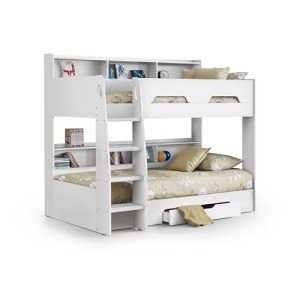A Comprehensive Guide to Children's Bunk Beds: Styles, Benefits, and Safety Considerations
Bunk beds have actually become a popular choice for families seeking to maximize space and provide a fun sleeping environment for children. With their unique design, they offer a creative and practical option for shared bedrooms, playrooms, and even guest accommodation. This short article checks out the numerous designs of children's bunk beds, their advantages, safety factors to consider, and responds to some regularly asked questions.
The Allure of Bunk Beds
Kid's bunk beds are more than just space-saving structures; they are also a gateway to daring dreams and imaginative play. Below is a detailed examination of their numerous advantages.
Benefits of Bunk Beds
- Space-Saving: Bunk beds effectively utilize vertical space, making them an ideal option for smaller sized spaces.
- Playful Design: Many bunk bed designs include slides, tents, and themed components, triggering creativity and enjoyment.
- Partner Sharing: Bunk beds are ideal for brother or sisters sharing a space or accommodating slumber parties.
- Flexible Use: Some designs can be separated into 2 individual beds, providing flexibility as children grow.
- Storage Options: Many bunk beds come with integrated drawer storage or racks, further enhancing their usefulness.
Styles of Children's Bunk Beds
The range of bunk beds readily available today deals with various preferences and requirements. Below is an overview of some popular styles.
| Style | Description | Best For |
|---|---|---|
| Standard Bunk Bed | A traditional design featuring one bed stacked above another. | Brother or sisters sharing a space. |
| Loft Bed | Similar to a bunk bed without the bottom bunk, permits a work area or play area below. | Restricted space for play/desk. |
| L-Shaped Bunk Bed | Two beds arranged in an L-shape, frequently with extra areas for storage or play. | Special room layouts. |
| Twin Over Full | A twin bed over a full bed, accommodating different sleep requirements. | Growing children and teens. |
| High Sleeper | Stands even higher than a loft bed, generally including a desk or play location below. | Older kids needing more play/desk space. |
| Camping Tent Bunk Bed | Bunk beds with a canopy or tent-like structure, creating a cozy, fun space. | Active and imaginative kids. |
Secret Features to Consider
When picking the ideal bunk bed for kids, the following features are worth thinking about:
- Material: Bunk beds can be made from wood, metal, or a mix. Each has its special visual and toughness.
- Weight Capacity: Always validate the weight limit of the bunk bed to guarantee it can accommodate your children securely.
- Security Rails: Ensure the leading bunk has sturdy rails to prevent falls.
- Ladder Security: A well-designed ladder needs to provide simple and safe access to the upper bunk.
- Ending up: Ensure any surfaces are non-toxic and safe for children.
Security Considerations
Security is paramount when it concerns children's bunk beds. The following guidelines ought to be adhered to:
- Age Appropriateness: Generally, kids under 6 years old need to not oversleep the upper bunk due to safety risks.
- Strong Construction: Ensure the frame and products are strong and can support the weight without drooping.
- Routine Maintenance: Periodically examine for loose screws, bolts, or other parts that might need tightening.
- Clear Play Area: Keep the location around the bunk bed devoid of toys and barriers to minimize tripping risks.
Setting Rules for Safe Use
Developing guidelines for bunk bed usage will assist guarantee security:
- Limit Jumping and Climbing: Children must be advised against leaping from the leading bunk and getting on the sides.
- Monitoring Sleepovers: Monitor young visitors while they are utilizing the bunk bed for the very first time.
- Educate on Ladder Use: Teach how to utilize the ladder securely, stressing the value of dealing with the ladder when going up or down.
Regularly Asked Questions
1. What age is appropriate for a child to sleep in the top bunk?
A lot of manufacturers advise that children must be at least six years old to oversleep the upper bunk. This guideline is developed to alleviate the risk of falls.
2. Can bunk beds be tailored?
Yes, many makers provide adjustable alternatives, consisting of colors, materials, and additional features like drawers or desks.
3. Are bunk beds safe for weight?
Bunk beds have weight limitations, typically varying from 200 to 400 pounds, depending upon the design and product. Always examine the manufacturer's specs.
4. How do I preserve and clean a bunk bed?
Frequently check for loose parts, keep the bed clean by wiping down surface areas, and make sure the bed linen is fresh to promote a safe and sanitary sleep environment.
5. Can bunk beds be separated into individual beds?
Numerous bunk beds feature a choice to separate them into two private beds, supplying long-term flexibility.
Children's bunk beds are more than mere furniture; they are a functional, versatile, and creative part of a kid's space. With various designs offered and various safety considerations to bear in mind, parents can pick the best bed that fits their space, fulfills their children's requirements, and instills a sense of experience. By understanding Bunk Bed Sales hilarybrun.top , styles, and safety procedures connected with bunk beds, families can produce a wonderful and safe sleeping environment for their kids. Whether for brother or sisters sharing a space or space-saving options, bunk beds stay a precious option for lots of households.

